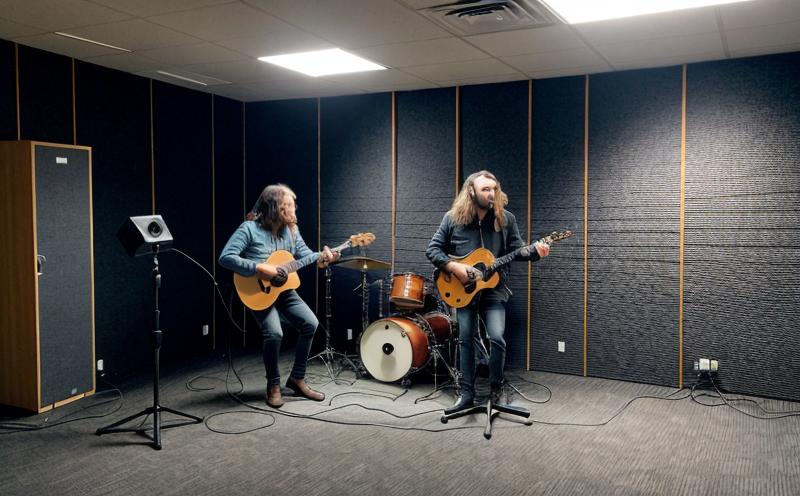ASTM E336 Airborne Sound Insulation Testing
The ASTM E336 standard specifies a procedure for determining the airborne sound insulation of partitions and ceilings in buildings. This test is critical for ensuring that walls, floors, and other structural elements effectively block noise between rooms within a building. By measuring the sound transmission loss (STL) at specific frequencies, ASTM E336 helps architects and engineers design spaces that meet acoustic comfort standards.
The testing process involves placing a standard test specimen in an acoustically treated room known as a reverberation chamber. A controlled noise source generates sound on one side of the partition while a microphone array measures the sound levels on the other side. The difference between the input and output sound levels is used to calculate STL, which indicates how well the material prevents sound from passing through.
ASTM E336 testing is particularly important for residential buildings, offices, schools, hospitals, and any environment where noise control is a priority. Compliance with this standard ensures that structures meet local building codes and regulations aimed at reducing noise pollution and enhancing occupant comfort.
The test procedure follows precise protocols outlined in the ASTM E336 standard to ensure consistency and reliability of results. The reverberation chamber used for testing must adhere to strict acoustic specifications, which include minimizing internal reflections and ensuring that the room's dimensions are appropriate for the frequency range being tested. This setup is crucial for obtaining accurate STL measurements.
For specimen preparation, test samples should be representative of the construction materials intended for use in the field. They must also be free from defects or irregularities that could affect the outcome of the test. The specimens are typically cut to standard sizes and positioned between two chambers within the reverberation room.
The testing process involves exposing one side of the specimen to a controlled sound source, while the other side is monitored for noise levels. The equipment used includes calibrated speakers for generating the sound stimulus and precision microphones for capturing the transmitted sound. The test results are analyzed using specialized software that calculates STL at various frequency bands.
ASTM E336 testing plays a vital role in ensuring the effectiveness of partitions and ceilings in controlling noise pollution. In residential settings, it helps prevent unwanted sounds from passing between rooms or to adjacent units. For commercial spaces like offices or schools, this test ensures that employees or students can work and study without being disturbed by ambient noise.
The results of ASTM E336 testing are typically reported in a detailed laboratory report, which includes STL values at various frequency bands. These reports serve as critical documentation for architects, engineers, and building owners to verify compliance with acoustic design specifications.
| Standard Number | Title of Standard | Publishing Body |
|---|---|---|
| ASTM E336-18 | Airborne Sound Insulation of Buildings | American Society for Testing and Materials (ASTM) |
Applied Standards
The ASTM E336 standard is widely recognized in the United States and internationally. It provides a robust framework for evaluating airborne sound insulation, ensuring that testing procedures are consistent across various applications. The standard covers the measurement of STL at multiple frequency bands to provide a comprehensive assessment of a partition's acoustic performance.
The ASTM E336-18 edition specifically addresses modern methods and considerations in building acoustics, making it suitable for contemporary construction practices. By adhering to this standard, laboratories ensure that their testing procedures are up-to-date with the latest industry standards and best practices.
International Acceptance and Recognition
The ASTM E336 standard enjoys broad international acceptance, particularly in countries where noise control is a key consideration. Many nations have adopted ASTM E336 as a reference for building codes, ensuring consistent standards across borders.
Compliance with ASTM E336 not only facilitates cross-border trade but also promotes harmonization of construction practices globally. This standardization helps reduce discrepancies in acoustic performance requirements between different jurisdictions, fostering a more seamless international market for HVAC and building materials.
By aligning with ASTM E336, manufacturers and builders can ensure their products meet recognized benchmarks, enhancing trust and credibility in the global marketplace.
Environmental and Sustainability Contributions
The ASTM E336 testing plays a crucial role in promoting environmental sustainability by reducing noise pollution. By ensuring that partitions and ceilings effectively block sound, this test helps create quieter environments, which is particularly beneficial for residential areas and public spaces.
Reducing noise levels can lead to several positive environmental impacts. For instance, lower noise exposure in urban environments can reduce stress among residents, improve sleep quality, and enhance overall well-being. In industrial settings, effective sound insulation can minimize the transmission of unwanted sounds into adjacent areas, contributing to a more harmonious work environment.
Moreover, ASTM E336 testing supports sustainable building practices by encouraging the use of materials that meet high acoustic performance standards. This approach not only enhances comfort for occupants but also contributes to the broader goal of creating healthier and more sustainable built environments.





